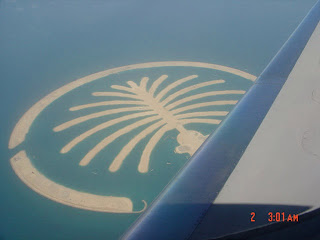The front left windshield cracked— it was on the captain’s side of the cockpit. We were still ascending and at an altitude of about 30,000 feet when it happened, having taken off from Doha International Airport, Qatar, about 30 minutes earlier!
I had been quietly standing behind the cockpit, minding my own flight attendant business, as the pilots were attending to theirs, when we all saw it crack. We looked at each other, sighed, and shook our heads in disbelief. Not again! The right windshield had cracked a couple of months before while we were in Gander, Newfoundland, just before take off, on our way across the “pond” (the North Atlantic Ocean) to London. But, no worries, there were double windshields on this private Gulfstream III aircraft. I was relieved to know that from the last experience.
However, this would still require that we make an immediate “unplanned landing”, according to FAA, and international regulations. The danger is that if something were to happen to the second, interior windshield, and we could experience a sudden decompression.
Doha, Qatar had been a fuel stop on our way from Madrid, Spain to Phuket, Thailand. Initially we were supposed to make that fuel stop in Dubai, United Arab Emirates, but foggy conditions had made for poor visibility, so we diverted to Doha. Now, we would descend to a safe altitude and figure out where to land. We needed to inform our boss, the owner of the airplane, who was currently sleeping restfully in the back.
The airplane was privately owned by a South American gentleman and his family — we’ll call him Mr. “D”. Our captain, John, asked me to inform Mr. D of the situation. I walked back aft, through the main cabin where his guests were snoozing. Gingerly, I knocked, then opened up the door to the aft cabin where he and his wife were sleeping. I tapped on his shoulder. They hadn’t even noticed that we were descending again.
The D family had owned airplanes, and flown around the world for many years, so they were used to, not only the turbulence, but also the drama that is part of private aviation. They would often sleep through re-fueling stops—landings and take offs—during the middle of the night. I quietly and calmly explained the situation and stepped out. Within a few minutes Mr. D came forward to inspect the windshield, and speak to the pilots. Instead of being upset and worried, he actually seemed, well...excited. It was yet another anecdote in his adventurous life.
John and Mr. D decided that it would be best to land in Dubai, rather than returning to Doha. This way, Mr. D and his wife and guests could go shopping, while we flew to Abu Dhabi to get the airplane fixed at a facility there.
We flew around for a few more minutes, waiting for the fog to lift, so that we could land at Dubai International Airport.
 |
| The United Arab Emirates |
Mr. & Mrs. D, and their guests were happy to have a shopping opportunity in luxurious Dubai. We, the crew, went shopping for a windshield in Abu Dhabi!
 |
| Abu Dhabi is also the "New York" of the UAE, a high rise financial center. |
 |
And, of course, the obligatory sign was painted on the ceiling of my hotel room, |






















